Introduction to Feeding Bottles
Feeding bottles are among the most essential tools for parents, especially during the first year of a child’s life. Whether you’re breastfeeding or formula-feeding, a reliable feeding bottle ensures your baby receives proper nutrition in a comfortable manner. However, with the overwhelming number of options available—from silicone to glass, wide-neck to narrow designs—choosing the right feeding bottle can feel daunting. This guide simplifies the process by breaking down critical factors like material safety, design ergonomics, and practical features. For instance, the best feeding bottle for infants must balance durability, ease of use, and compatibility with your baby’s developmental stage.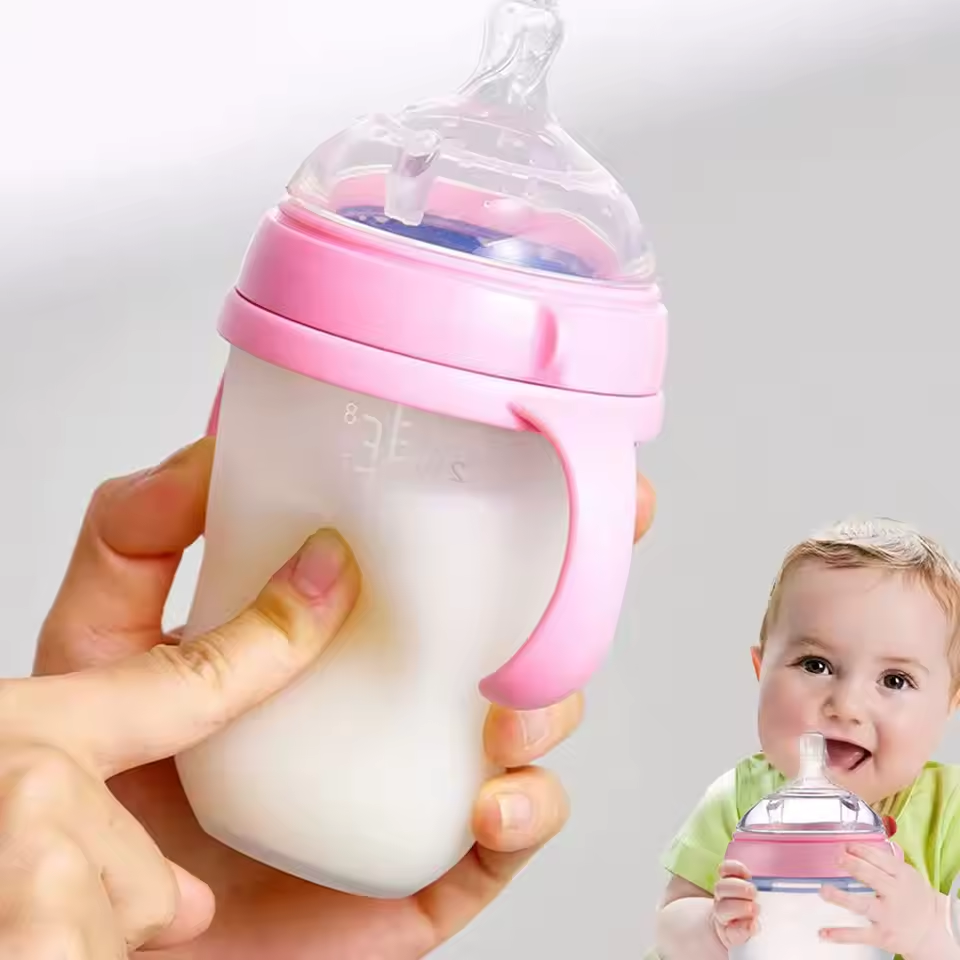
Modern parents also face unique challenges, such as balancing convenience with sustainability or adapting to their child’s evolving needs. From ergonomic shapes that mimic breastfeeding to innovative anti-colic systems, today’s feeding bottles are designed to address common issues like gas, spills, and hygiene concerns. Yet, with so many choices, it’s easy to feel overwhelmed. By understanding key considerations like nipple flow rates, material safety certifications, and ergonomic design, you can make an informed decision that prioritizes both your baby’s comfort and your peace of mind. By the end of this article, you’ll have a clear roadmap to select a product that meets your family’s needs.
Key Features to Consider When Selecting a Feeding Bottle
When choosing a feeding bottle, prioritize functionality and safety over aesthetics. Here are the top features to evaluate:
1. Material Safety
Opt for BPA-free materials like glass, silicone, or FDA-approved plastic. Glass is hygienic but fragile; silicone/plastic are lightweight and shatterproof. The best feeding bottle for infants often combines materials (e.g., silicone sleeves around glass) to balance safety and durability.
2. Flow Rate
Newborns need slow-flow nipples to prevent choking, while older infants may require faster flow rates. Adjustable systems let parents switch nipples as their baby grows. Consult a pediatrician for medically fragile infants.
3. Anti-Colic Design
Trapped air causes discomfort—look for bottles with vents, collapsible bags, or angled shapes. Brands like Dr. Brown’s and Philips Avent use systems that eliminate vacuum pressure, reducing gas and fussiness.
4. Ergonomics
Choose bottles with comfortable grips, lightweight designs, and angles that align with a baby’s posture. Narrow-neck options suit tiny mouths, while textured surfaces aid parental grip.
5. Cleaning Ease
Wide openings and detachable parts simplify cleaning. Dishwasher-safe bottles save time, but handwash silicone to avoid odor retention. Stackable components save storage space.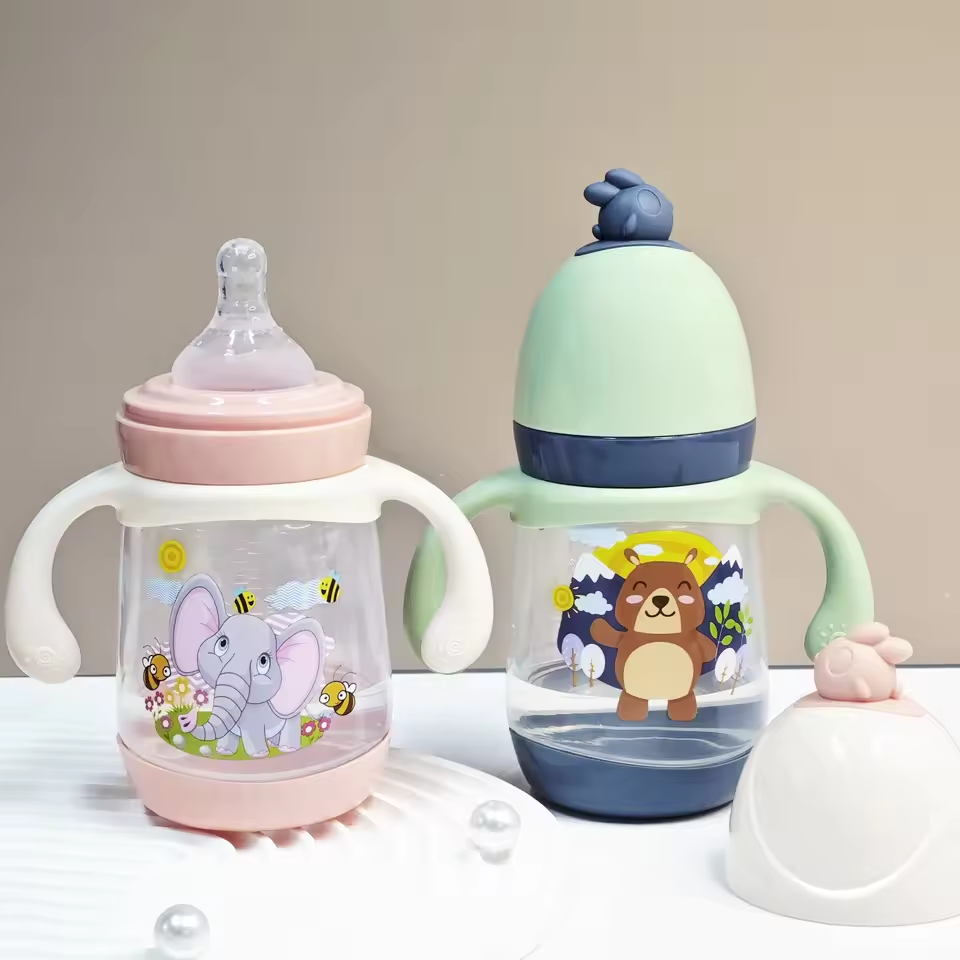
Additional Tips:
- Capacity: Start with 4–6 oz (120–180 mL) for newborns, scaling up as they grow.
- Brand Trust: Prioritize brands with transparent safety records and responsive support.
- Travel-Friendly: Opt for collapsible or compact designs for on-the-go use.
By focusing on these features, parents can select a feeding bottle that supports their baby’s needs, reduces feeding struggles, and ensures a safe, comfortable experience.
Understanding Different Feeding Bottle Materials
A feeding bottle’s material impacts safety, durability, and usability. Here’s a quick guide to common options:
1. Glass
Transparent and non-porous, glass is easy to sterilize and retains no odors. However, it’s heavier and more fragile than plastic. Ideal for parents prioritizing hygiene, though silicone sleeves can add shatter resistance.
2. Silicone
Flexible and lightweight, silicone bottles are shatterproof and comfortable for infants. They’re easy to clean but may retain odors if not washed thoroughly. A popular choice for on-the-go parents.
3. Plastic (PP/PET)
Affordable and durable, plastic bottles are widely available. Ensure they’re BPA-free and free from phthalates. Opt for rigid plastics for durability or softer options for squeezable feeding.
4. Medical-Grade Resin (PPSU)
A premium option, PPSU is heat-resistant and lightweight. It resists scratches and doesn’t leach chemicals, making it a top pick for long-term use. However, it’s pricier than other materials.
Design Innovations That Make a Difference
Modern feeding bottles leverage cutting-edge designs to enhance usability and comfort. These innovations address common challenges like gas, spills, and feeding transitions:
1. Anti-Colic Systems
Bottles with internal vents, collapsible bags, or pressure-equalizing valves prevent air ingestion. For example, Dr. Brown’s patented inner vent system collapses the bottle’s air space, mimicking breastfeeding to reduce gas and fussiness.
2. Wide-Neck Openings
Larger openings simplify cleaning and accommodate formula scoops or vitamin drops. Some bottles include wide nipples for easier latching, ideal for babies transitioning from breastfeeding.
3. Ergonomic Angles
Bottles with curved shapes or angled bases encourage optimal feeding posture, reducing neck strain. This design also ensures milk flows smoothly to the nipple, minimizing spills.
4. Smart Leak-Proof Mechanisms
Innovations like silicone seals or magnetic lids prevent leaks during travel. Some bottles feature collapsible valves that close when not in use, maintaining hygiene.
5. Temperature-Sensitive Nipples
Nipples that soften or harden based on milk temperature help babies adapt to ideal feeding conditions. This reduces discomfort from overly warm or cold milk.
6. Modular Systems
Bottles like the Philips Avent Natural line offer interchangeable parts—parents can swap nipples, valves, and bottle bodies as their baby grows, reducing the need for multiple bottles.
7. Eco-Friendly Materials
Sustainable designs prioritize recyclable plastics or bamboo-based components, appealing to eco-conscious parents while maintaining safety and functionality.
These innovations prioritize both baby comfort and parental convenience. For instance, the best feeding bottle for infants might combine an anti-colic system with a wide-neck design, ensuring easy cleaning and reduced gas. Parents should test features like angle-friendly curves or modular parts to match their child’s needs. Always verify that innovations (e.g., smart valves) don’t compromise hygiene or durability.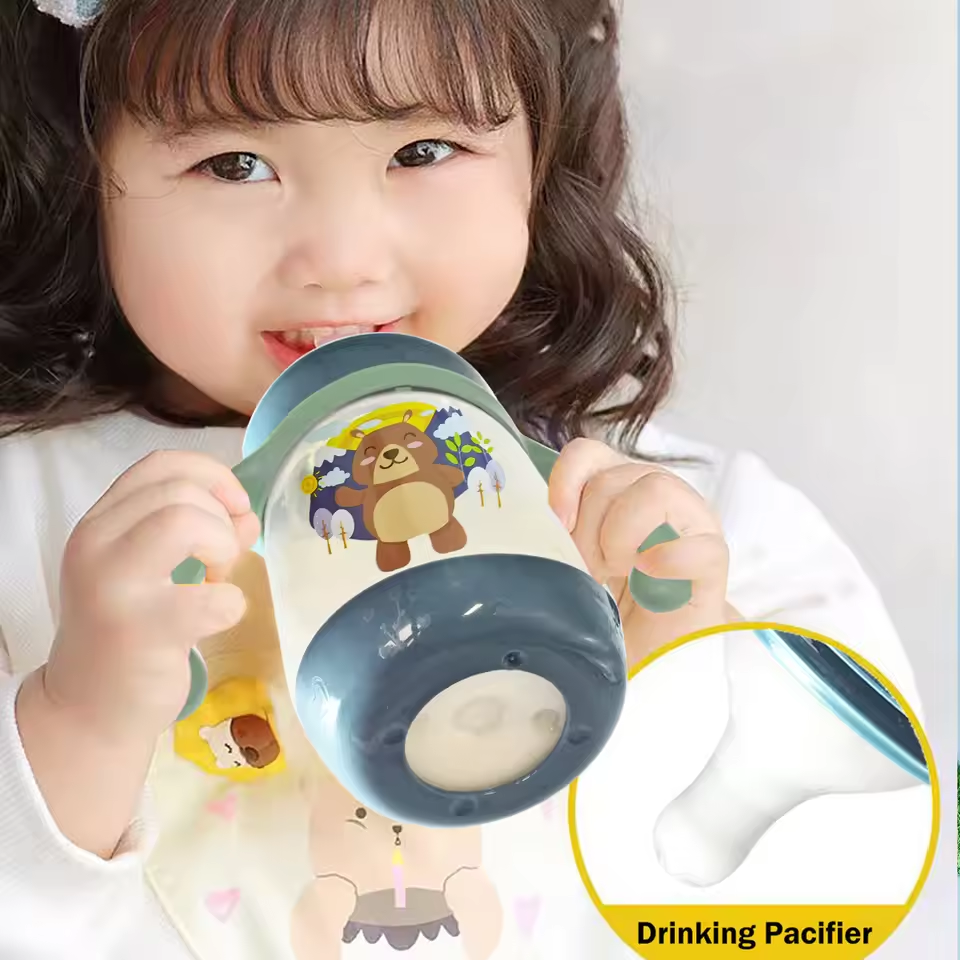
Safety Practices for Bottle Feeding
Prioritizing safety ensures a feeding bottle supports your baby’s health. Follow these guidelines:
1. Sterilization
Sterilize new bottles by boiling for 5 minutes or using a microwave/UV sterilizer. After each use, wash with hot, soapy water and air-dry.
2. Temperature Checks
Test milk on your wrist before feeding—ideally between 98°F–100°F (37°C–38°C). Never warm bottles in microwaves, which can create hotspots.
3. Storage Rules
- Prepared formula left at room temperature must be discarded after 2 hours.
- Refrigerate unused portions within 30 minutes and use within 24 hours.
4. Inspect for Damage
Regularly check bottles for cracks, warped nipples, or worn seals. Replace parts immediately if compromised.
5. Positioning
Hold your baby upright during feeds to reduce choking risks. Support their head and tilt the bottle so milk fills the nipple.
6. Hygiene Habits
Wash hands before handling bottles. Avoid prepping formula in advance—always mix fresh portions.
7. Allergy Awareness
If using formula, follow pediatrician recommendations for allergens. Store bottles away from chemical cleaners or toxins.
The best feeding bottle for infants should be easy to clean and made from non-toxic materials to minimize risks. Never leave a feeding bottle propped in a crib—always supervise feeds. If your baby shows signs of choking or allergic reactions, seek medical advice immediately.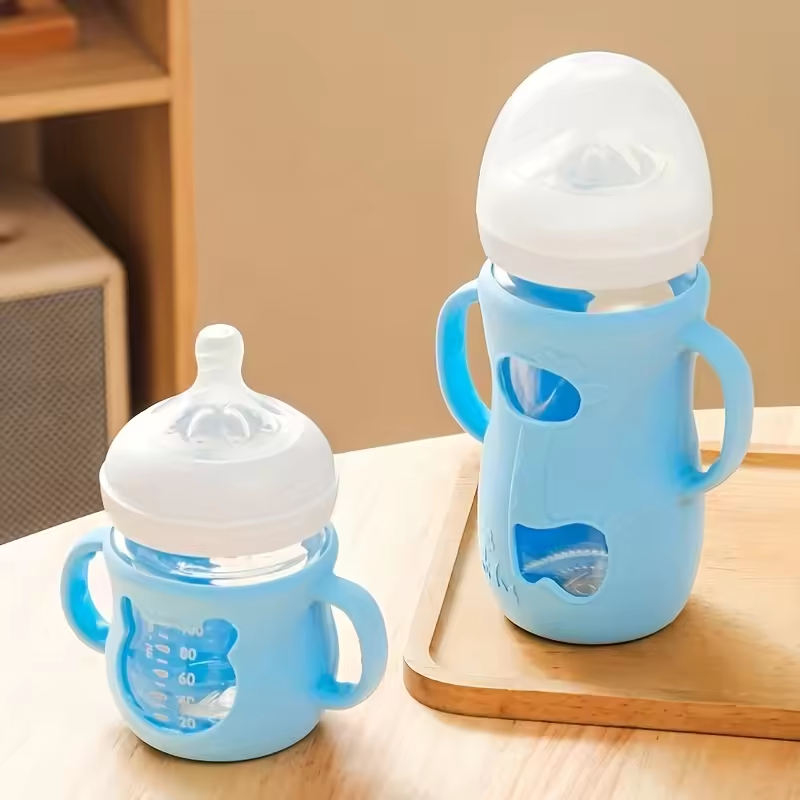
Tips for Successful Bottle Feeding
Bottle feeding becomes smoother with these strategies:
1. Optimal Positioning
Hold your baby upright, supporting their head and neck. Tilt the feeding bottle so milk fills the nipple to avoid air intake.
2. Patience and Pace
Let your baby set the feeding speed. Pause if they turn away, burp them, then resume. Avoid forcing them to finish a bottle.
3. Temperature Control
Test milk on your wrist—ideally lukewarm. Use a bottle warmer or run warm water over the container to avoid scalding.
4. Experiment with Nipples
If your baby refuses feeds, try nipples with different flow rates or textures. Some infants prefer silicone for its softness.
5. Create a Calm Environment
Minimize distractions—feed in a quiet, well-lit space. Play soft music or talk gently to soothe your baby.
6. Burp Frequently
Pause feeding every 2–3 ounces to release trapped air. Pat their back gently until they burp.
7. Adapt to Needs
Adjust feeding times if your baby is fussy or unwell. Use the best feeding bottle for infants (e.g., anti-colic designs) during growth spurts or teething phases.
8. Clean as You Go
Wipe spills immediately to prevent messes. Rinse the bottle after use to avoid formula residue buildup.
By combining patience, adaptability, and the right tools, parents can turn feeding sessions into calm, nourishing experiences. Always prioritize your baby’s cues over strict schedules.
Top Brands and Their Unique Selling Points
The market is flooded with brands, each touting unique features. Here’s a quick overview of leading options:
- Dr. Brown’s: Known for its patented internal vent system that eliminates colic.
- Philips Avent: Offers a range of ergonomic designs, including anti-colic bottles with natural flow technology.
- Comotomo: Made from medical-grade silicone, these bottles mimic breastfeeding for easier transitions.
When comparing brands, read customer reviews to identify common issues like leaks or durability problems. The best feeding bottle for infants often depends on your baby’s preferences—for example, a Comotomo bottle might work better for a child with sensitive gums, while Philips Avent excels for reflux-prone infants.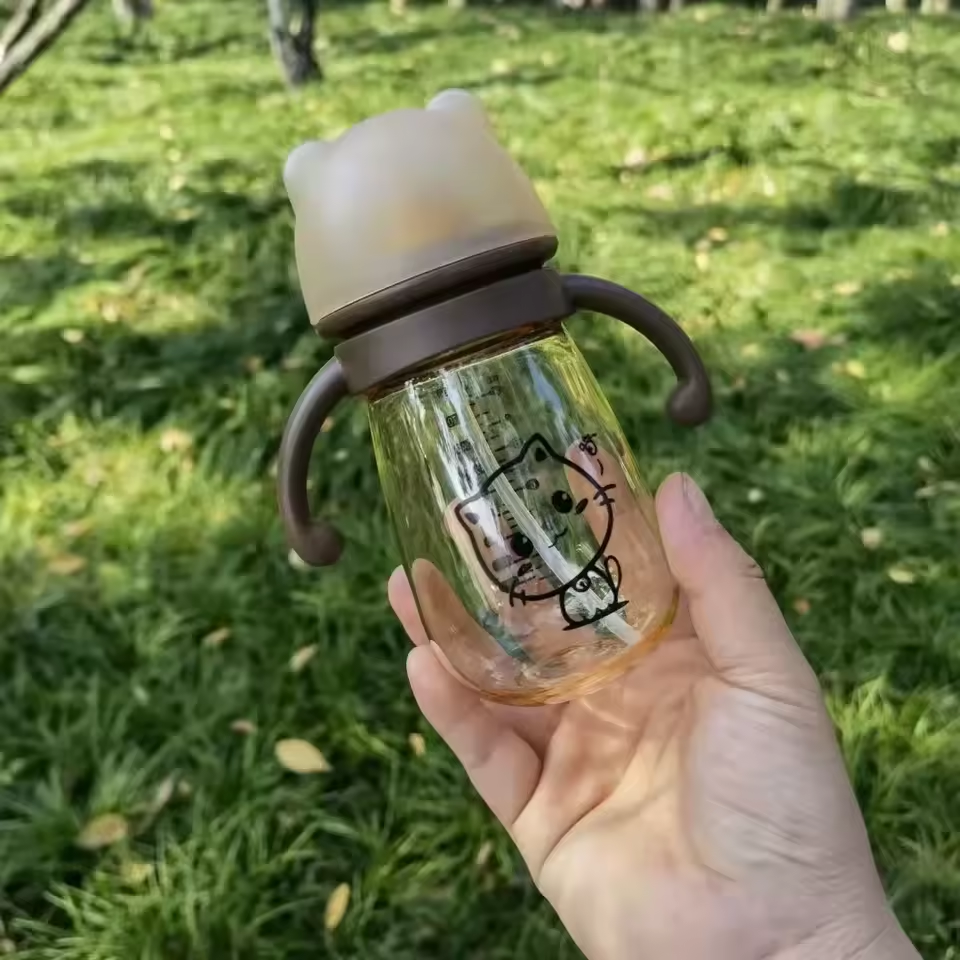
Common Challenges and Solutions
Leaky bottles often stem from loose nipples or damaged seals—tighten parts securely and replace worn components promptly. If your baby resists feeding, try different nipple shapes or temperatures; some infants prefer warm milk, while others adapt better to room-temperature feeds. Gas buildup can be minimized by using anti-colic bottles and burping frequently during feeds. For slow drinkers, ensure the nipple has the correct flow rate for their age; newborns need slow flows, while older babies may require faster options.
Discomfort from sore gums? Offer a cooled teething ring before feeding or choose soft silicone nipples that mimic breastfeeding. Bottles left uncleaned can harbor bacteria, so wash them immediately after use and sterilize daily. If leaks persist despite proper assembly, consider investing in a high-quality, leak-proof feeding bottle designed for snug fits. Always inspect bottles before feeds for cracks or deformation, and consult a pediatrician if refusal persists—it could signal illness or developmental needs. Prioritizing these fixes ensures smoother, stress-free feeding sessions.
Conclusion
Selecting the right feeding bottle is a cornerstone of infant care. By focusing on material safety, design innovation, and practical features, parents can ensure their baby enjoys comfortable, safe feedings. The best feeding bottle for infants is one that adapts to your child’s needs while prioritizing your peace of mind. Regular maintenance, proper storage, and patience will further enhance the experience. Whether you’re navigating your first feeding or upgrading your collection, this guide equips you with the knowledge to make informed decisions that foster a healthy, happy baby.